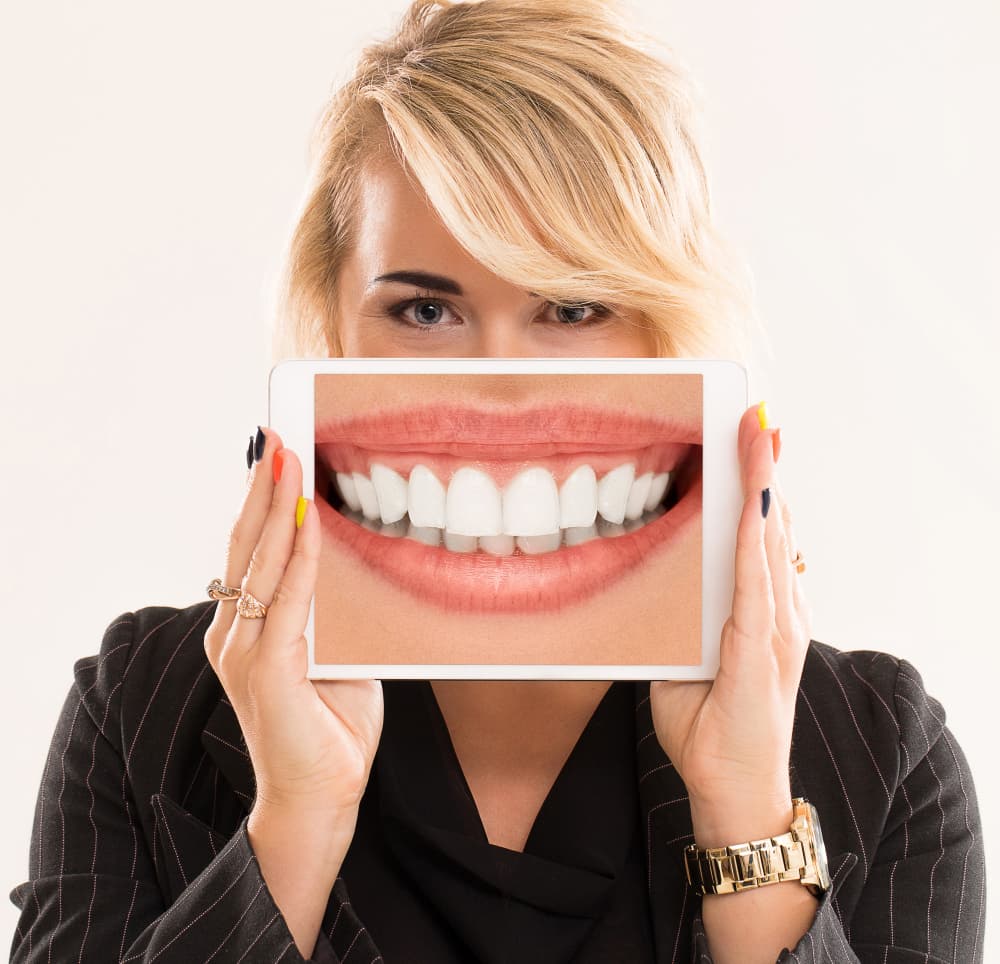
As aesthetic concerns grow in importance today, teeth whitening continues to be a popular practice. A bright, white smile can boost our confidence and make us appear more attractive. However, getting accurate information about teeth whitening isn’t always easy. There are countless methods and products on the internet and social media that are not only ineffective but sometimes even harmful.
In this article, we will debunk common myths about teeth whitening and share with you what truly works. Additionally, we’ll provide guidance on what to watch out for after a whitening treatment and who can benefit from it. This way, you can make more informed decisions and achieve a healthy, white smile.
Common Teeth Whitening Myths
When it comes to teeth whitening, you may come across numerous “miracle” methods online and on social media. However, most of these methods lack scientific basis, and some can even cause serious damage to your teeth. Here are some common misconceptions about teeth whitening:
1. Whitening Teeth with Baking Soda and Lemon
Baking soda and lemon are often believed to be natural substances that remove stains from your teeth. However, this mixture has the potential to damage your teeth. The abrasive nature of baking soda combined with the acidic properties of lemon can weaken tooth enamel, making your teeth more sensitive and increasing the risk of cavities.
2. Banana Peel
It is claimed that minerals like potassium, magnesium, and manganese in banana peels help whiten teeth, but there is no scientific evidence to support these claims. Rubbing your teeth with a banana peel might not be harmful as long as it doesn’t damage the enamel, but it is not effective for whitening. You might benefit more from eating a banana than rubbing the peel on your teeth!
3. Apple Cider Vinegar
Apple cider vinegar’s acidic nature might seem effective for removing stains, but it can also erode tooth enamel, weakening your teeth and leading to sensitivity. Using apple cider vinegar for teeth whitening can damage your teeth in the long run. Therefore, it is much safer to rely on professional whitening methods.
4. Whitening Teeth with Strawberries
The malic acid found in strawberries can have a limited effect in removing stains from teeth. However, this whitening effect is minimal, and the acid can damage your enamel. Also, the sugar in strawberries can increase the risk of cavities. Instead of using strawberries for whitening, it’s better to opt for safer and more effective methods.
5. Gargling with Hydrogen Peroxide
Hydrogen peroxide is commonly used in teeth whitening products, but using it to gargle at home can irritate the gums and lead to tooth sensitivity. There is also the risk of damaging enamel if misused. If you want to use hydrogen peroxide, always consult your dentist and opt for professional products.
6. Brushing with Salt
The abrasive quality of salt might be effective for removing stains, but it can damage tooth enamel, leading to sensitivity. Instead of brushing with salt, use gentle toothpaste that doesn’t harm enamel and follow whitening methods recommended by dentists.
7. Other Myths (Coconut Oil, Activated Charcoal, etc.)
There are various claims that substances like coconut oil and activated charcoal are effective for teeth whitening. However, these claims lack sufficient scientific support. These substances can damage the enamel and cause sensitivity, making them unreliable.
If you want reliable and effective results for teeth whitening, it is recommended to opt for professional methods. The safest step for your dental health is to use treatments and products suggested by your dentist.
Teeth Whitening Facts

If you want effective and reliable results in teeth whitening, it is important to rely on scientifically proven methods. Professional teeth whitening treatments are among the most reliable and effective options for this purpose.
In-Office Whitening
In-office whitening is a procedure performed at the dentist’s office that quickly brightens the color of your teeth. This method involves applying a high-concentration whitening gel to your teeth, which is then activated with a special light or laser. As a result, stains are quickly removed, and visible changes are typically achieved in a single session.
Steps of the Procedure:
- Your initial tooth color is determined using a shade guide.
- Your gums and lips are covered with a protective gel.
- Whitening gel is carefully applied to your teeth.
- The gel is activated with a special light or laser to enhance its effect.
- The gel is left on your teeth for a specific duration and then removed.
- If necessary, the process can be repeated.
At-Home Whitening
At-home whitening is a method applied at home under the guidance of a dentist. In this method, you use a whitening gel in trays specifically customized for your teeth. The trays are filled with whitening gel and kept on the teeth for a certain amount of time. Although at-home whitening takes longer compared to in-office treatments, it is more cost-effective and can be done at your convenience.
Active Ingredients in Teeth Whitening Products
The most common active ingredients in teeth whitening products are hydrogen peroxide and carbamide peroxide, which are peroxide derivatives. These ingredients work by breaking down stains on the enamel through oxidation, brightening the color of the teeth. When used under professional supervision, these professionally formulated whitening products are both safe and effective.
How Long Does Teeth Whitening Last?

The effectiveness of teeth whitening can vary based on factors such as oral hygiene, diet and lifestyle. Typically, the whitening effect lasts between several months to a year. Regularly brushing your teeth, using floss, and avoiding foods and drinks that cause stains can help maintain the whitening effect for longer.
Post-Whitening Care
It’s important to follow some steps to maintain your bright smile and support dental health after a teeth whitening procedure. Here’s what to keep in mind:
1. Diet
After whitening, your teeth may temporarily be more susceptible to stains. Therefore, it is best to avoid foods and drinks that can cause staining for a while. Coffee, tea, red wine, cola, cherry juice, and foods with colorful sauces can lead to tooth discoloration. Instead, opt for tooth-friendly options like:
- Water and milk as beverages,
- White cheese and apples as non-staining foods.
Protecting your teeth with these healthy options after whitening will help you maintain the results for a longer period.
2. Oral Hygiene
Maintaining proper oral hygiene after whitening is very important. You should brush your teeth at least twice a day and use floss to clean between your teeth. Additionally, visiting your dentist regularly for professional cleanings will help preserve the whiteness of your teeth. This kind of care will ensure your teeth stay both white and healthy.
3. Tooth Sensitivity
Some people may experience tooth sensitivity after whitening. This sensitivity is usually temporary and subsides within a few days. If you experience sensitivity, you can try the following:
- Use toothpaste for sensitive teeth.
- Apply fluoride treatments recommended by your dentist.
These methods can help reduce sensitivity quickly and make you feel more comfortable.
Who Can Get Teeth Whitening?
Teeth whitening is a suitable cosmetic procedure for many people. However, in certain situations, teeth whitening is not recommended. Here are the suitable candidates and situations in which the procedure is discouraged:
Suitable Candidates
Generally, individuals with healthy teeth and gums are good candidates for teeth whitening. This method is highly effective in removing stains caused by factors like coffee, tea, smoking, and aging. However, it’s important to note:
- Restorations like veneers, fillings, or bridges do not respond to whitening. These types of restorations can be replaced before or after whitening if necessary.
Unsuitable Situations
There are circumstances where teeth whitening is not recommended. These include:
- Pregnancy and Breastfeeding: Whitening is not recommended for pregnant or breastfeeding women, as it is not yet fully known whether whitening agents can harm the baby.
- Tooth Decay or Gum Disease: People with tooth decay or gum disease should not undergo whitening before these issues are treated, as whitening agents can exacerbate these conditions.
- Tooth Sensitivity: If you have sensitive teeth, whitening agents can worsen the sensitivity.
- Allergies: If you are allergic to any ingredients in whitening products, you should avoid this procedure.
- Under 18 Years of Age: Whitening is not recommended for individuals under 18, as the development of tooth enamel is not yet complete, and whitening agents could harm their teeth.
Before undergoing teeth whitening, it is essential to consult with a dentist. Your dentist will evaluate your teeth and gum health to determine if this treatment is suitable for you.
Recent Posts
-
 Effective Solutions for Seasonal Hair Loss: What Treatments to Consider04 Feb 2025
Effective Solutions for Seasonal Hair Loss: What Treatments to Consider04 Feb 2025 -
 Does the Density of Hair Transplants Matter? Achieving a Full Look04 Feb 2025
Does the Density of Hair Transplants Matter? Achieving a Full Look04 Feb 2025 -
 Look Younger: Mini Facelift and Neck Rejuvenation02 Feb 2025
Look Younger: Mini Facelift and Neck Rejuvenation02 Feb 2025 -
 Can Ozone Therapy Really Boost Your Mood and Energy Levels?02 Feb 2025
Can Ozone Therapy Really Boost Your Mood and Energy Levels?02 Feb 2025 -
 Say Goodbye to Static: How to Get Rid of Static in Hair29 Jan 2025
Say Goodbye to Static: How to Get Rid of Static in Hair29 Jan 2025

